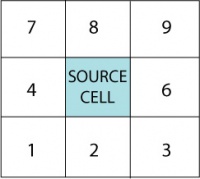Labs ERODE
Hydrology and Flow Routing
This lab introduces you to raster-based flow routing; this basic concept of flow routing is a key process in many hydrological and sediment transport models. It is also used in watershed or catchment delineation in GIS applications.
it evolves a landscape with a combination of hillslope erosion and transport and river channel erosion and transport. Download an introductionary presentation of the landscape evolution model Erode.
Learn about Flow Routing
An important part of any landscape evolution model is the way it treats routing of water (and sediment) through the landscape. To give you a bit of a feel of the methodology, we will look at the ‘D8 method’ for determining the drainage directions in a raster grid.
Assume you have a 3 by 3 grid. So if one has a source cell of interest in the middle, we assume that water and sediment drains in the direction of the steepest slope. This concept is also called ‘steepest descent’. The grid cell in the middle then has 8 neighboring cells, and depending on their elevations (z), and the distance between the cells, d, you can calculate the slope, S.
<math>S = \Delta z / d </math> (1)
These surrounding cells are coded as shown in the figure here:

Question In the hypothetical elevation grid below, the source cell and its 8 neighbors have defined elevation values. Where does the water drain to? Select the correct cell and list its D8- grid value.
Question Can you think of a theoretical situation when a D8 flow direction algorithm would not work? What would such a situation look like in a real DEM?

